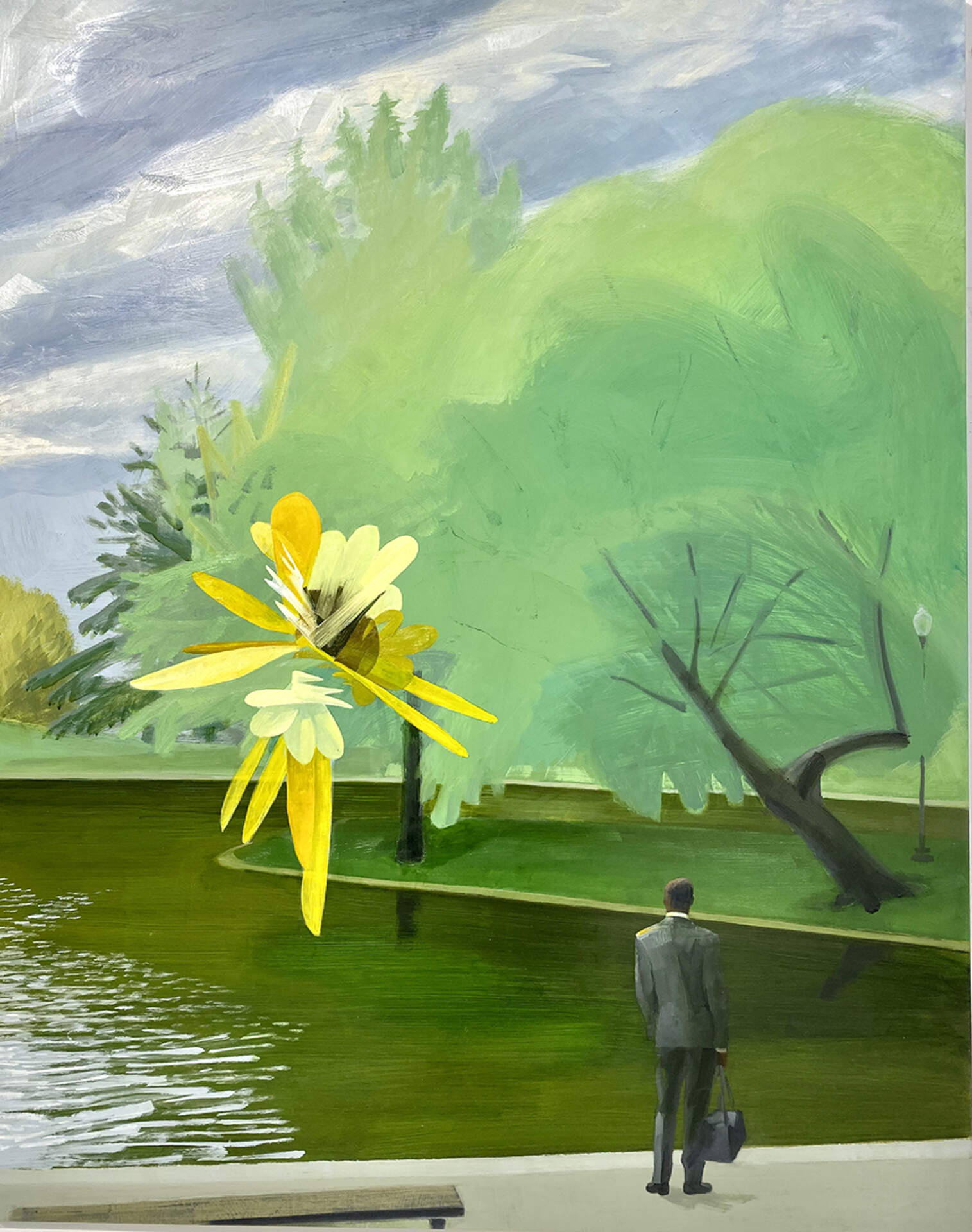Mike Glier (b. 1953)Song Sparrow Singing in the Boston Public Garden
2020
oil on aluminum panel
40" x 32"
Collection of Gabriella Ojeda-Badillo and Benjamin Schwartz
CREATING HOPE
MG: So, here we are at the last pairing. Sunshine and Rain is a thriller, which is a funny way to describe a picture of a rainy day! Where is this and what kind of tree do you think it is?
NW: The Albarella family’s pear tree next door appears in several paintings, but to my mind, the title is a clue to a far more significant subject. Sunshine and Rain are essential ingredients for life. Nothing exists without them. And if you’re lucky, you will see a rainbow as the rain dissipates.
MG: The pear tree is igniting with bloom! The magic is once again in the motif, here a repeated blade shape, tipped with flares of yellow and green that radiate from the central trunk. It reminds me of the resurrection panel of Grunewald’s Isenheim altarpiece, where Christ is rising from the tomb in a burst of light with shroud trailing like a celebratory flag. But this time the awakening figure is a tree which draws from the dark resources of the soil to exploit the light and air for its need to set fruit. The story of the Resurrection is a necessary story for many human beings, but Burchfield makes his secular version primordial, humorously set in his neighbor’s backyard!
NW: I’m surprised to hear such a Christian interpretation. I agree with the Whitney’s former director, John I. H. Baur, that Burchfield was truly a pantheist. He struggled with embracing organized religion for decades, finally conforming to society’s pressures and joining his pious wife’s Lutheran church a few days before his 51st birthday. The event, which included his son Arthur joining the church too, was documented in eleven words in his journals. However, four days later he and Art took a trip to Gowanda and were “in complete harmony” exploring the canyon and woods, skipping stones, watching a hawk, crossing a ravine, and splashing in water—the event chronicled in 631 words. What a contrast.
I think the pear tree mimics the shape of its leaves. The sturdy trunk bursts with his “flame of spring” effect so every tiny, yearning branch captures life-giving light and water as do the dandelions dancing across the foreground.
MG: I take your point about the shape. But the burst of light from within the trees is common in religious pictures of the resurrection, as is the upward gesture of the arms of Christ, which is similar to the upward arc of each branch of the tree. I don’t think artists need to be religious to quote effective pictorial devices used in religious painting. My painting, Song Sparrow Singing is also about renewal and to my surprise I also used conventions of religious art. It’s spring and a man has paused to listen to a bird call, which appears as a collection of golden feathers in a cross shape suspended in mid-air, like Gabriel hovering before Mary. I chose gold and the cross shape because they felt uplifting. Only later did I recognize the historical source for my choices. It’s important, I think, that the man in my picture is dressed for business, briefcase in hand, but stands relaxed in a classic contrapposto, as if the song has provided respite from a busy day. This is a secular scene that relies on conventions of religious art for its emotion.
NW: I read the song sparrow form more like a woodland fairy from a children’s book. In other works, Burchfield represents birdsong notes, chirps, and trills in undulating waves into the air. Unconsciously he foreshadows today’s spectrograph documentation.
MG: I’m glad we are ending on a hopeful note. In fact, I’d argue that both pictures intentionally create hope. Hope may be a delusion, but a necessary one for our species to face adversity and carry on. Hope has usually been the panacea of religions, which have marshaled its healing power through resonant storytelling. But being human institutions, religions are political in nature and sometimes use hope for purposes with which I do not agree. So, it’s important to find hope in secular places as well. If I had to say one thing that most inspires me about Burchfield, it is the ability to create hope. Of course he makes gloomy pictures as well; he understands that hope and despair are two sides of a coin that is the human condition. He’s realistic. But in the end, he celebrates the miracle of life on the planet and the joy of being a part of it like few artists have done before or since.
